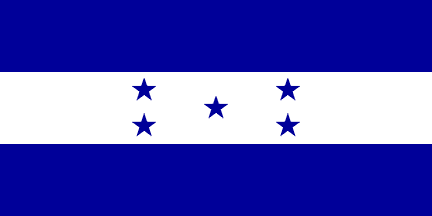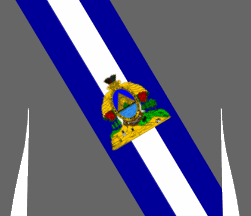![[Flag of Honduras]](../images/h/hn.gif) image by Željko Heimer, 1 November 2001
image by Željko Heimer, 1 November 2001Flag according to Clay Moss report

Last modified: 2024-04-20 by rob raeside
Keywords: honduras |
Links: FOTW homepage |
search |
disclaimer and copyright |
write us |
mirrors
![[Flag of Honduras]](../images/h/hn2022.gif) image by Jason Saber, 7
January 2022
image by Jason Saber, 7
January 2022Official Name: Republic of Honduras
(Republica de Honduras)
Flag adopted: 9
January 1866
Coat of Arms adopted: 3 October 1825
See also:
As part of the purpose of starting a new government, focusing on foundations
of institutionality and national identity, the President-elect Xiomara Castro De
Zelaya has given instructions starting January 27, the date of the transfer of
presidential command of Honduras, that the general use of the official color is
established from the National Flag. The legal description in the Constitution of
the Republic, provides for the following:
Article 1. - Reform Legislative
Decree No. 7 of February 16, 1866, which creates the National Flag, which will
be read as follows:
Art. 1. The National Flag of Honduras will consist of
three equal and horizontal stripes, the upper and lower of TURQUOISE BLUE COLOR,
the white center and will carry in between five stars of five rising angles of
the same blue color, forming with four of them a parallel quadrilateral to the
stripes, being placed the rest in the center of the same quad. The width of the
set of the three branches should be contained twice the length.
The Joint
Chief State (Armed Forces) has already issued an ordinance to proceed, starting
January 17, with the change of flags at all the headquarters of this entity and
in the uniforms of the country's armed body. For some this is an initiative
irrelevant to the country's structural problems, but we recognize that starting
by creating identity and respect for patriotic symbols, creates a culture in
favor of institutional respect and citizen defense.
Source:
https://www.facebook.com/RFCentroamerica/
Jason Saber, 7
January 2022
The website at
https://tiempo.hn/unah-confirma-usara-azul-turquesa-en-bandera-nacional/
provides some context on the change to the turquoise. Universidad Nacional
Autónoma de Honduras (UNAH) adopted these colors to serve as the flag used at
their campus due to the historical nature of turquoise being the main colors
used in the original national flag. This color is going to be used in all
branding and uniforms of the Armed Forces on 17 January (https://conexion.hn/2022/01/ffaa-usara-la-bandera-nacional-en-color-azul-turquesa-a-partir-del-17-de-enero/)
and will be at the inauguration of President-elect Xiomara Castro.
Zachary Harden, 7 January 2022
Xiomas Castro wore a new Presidential Sash of turquoise blue at the
inauguration ceremony on Jan 27th and resumed the same color of the national
flag based on Flag law No29 issued on Jan18 1949.
https://www.bnamericas.com/en/analysis/how-honduras-new-president-could-achieve-her-ict-goals
Nozomi Kariyasu, 28 January 2022
In this letter sent to the Mexican Senate from the Government of Honduras (https://infosen.senado.gob.mx),
the letter states the color chosen in 2022 for the turquoise blue color is
Pantone 3105. For reference, the color can be seen at
https://www.pantone.com/eu/en/connect/3105-C. The Pantone shade was also
required to be used on national flags used in passports, according to this
tender notice (https://inm.gob.hn/INM.LPI.001.2022.04.10.22%20Final.pdf).
Zachary Harden, 30 March 2024
![[Flag of Honduras]](../images/h/hn.gif) image by Željko Heimer, 1 November 2001
image by Željko Heimer, 1 November 2001
Flag according to Clay Moss report
 image by Željko Heimer, 1 November 2001
image by Željko Heimer, 1 November 2001
Flag according to Album 2000 [pay00]
In Carlo A. Ferro's book: The Argentine flag, inspirer of
the Central American banners, Honduras chose the same
international naming for white, but curiously not for blue, which
is defined as "turquí" (turquoise?), i.e., dark blue.
Gus Tracchia, 27 November 2000
While visiting Honduras I did not saw a Honduran flag anywhere
that looks like and illustration floating around on a flag chart
or in an encyclopedia. All Honduran flags are proportioned
1 to 2. The constellation of 5 stars on Honduran flags is
spread out much further than what illustrations show.
Starting from the hoist, the first 2 stars are placed at a point
1/3 the length of the flag. The middle star is placed in
the center, and the last 2 stars are placed at a point 2/3 the
length of the flag from the hoist. Also, the stars, though
5 pointed are not the American variety. Each point is wider
at the center. Here is an illustration.
Clay Moss, 5 July 2001
According to Album 2000 [pay00]
- National Flag (CSW/CS- 1:2) - Horizontal triband of
blue-white-blue with five blue stars in the middle stripe. Clay
Moss is stating that all (most?) the flag is Honduras itself use
"fat" stars, and he further gives the construction
details, that I interpret. The Album gives similar image, but
with more traditional stars.
Željko Heimer, 1 November 2001
The image shown in the Album 2000 is correct according to
Figures 4 and 5 of a Decree dated 18 January 1949 (reproduced in
the Folleto Civico of 15 September 1965). This shows that
the stars are set within an imaginary rectangle one-third of flag
length, and that they are conventionally shaped (as in the US
flag). There is no size given for the stars, but from
Figures 4 & 5 I have calculated them to be contained within
an imaginary circle of diameter = 1/18 of flag width.
Incidentally, the flag with stars set closer together (as in the
Flaggenbuch) is based on accuardo no. 194 of 27 September 1933,
and it was originally established by Law No. 7 of the National
Congress dated 19 January 1866.
The colour 'azul turquesa' or 'azul turqui' was defined by an
amendment published in the Folleto Civico of the same date.
Based upon a copy of the Folleto Civico supplied by Armand du
Payrat, and upon information by Ralf Stelter copied from the Flag
Institute files.
Christopher Southworth, 2 March 2003
Fred Drews reported: "I was recently in Honduras. The
Honduras flag definitely has the stars spread out we have
them". The spread-out stars date from a regulation of 1949.
Christopher Southworth, 7 October 2004
From Flags of the World (Talocci 1982):
Honduras achieved independence in 1821 as part of the Central
American federation along with El Salvador, Costa Rica,
Nicaragua, and Guatemala. The present flag, which was officially
adopted in 1949, is similar to that of the federation, which came
to an end in the years 1838 to 1839.
The blue bands stand for the Caribbean Sea and the Pacific Ocean.
The five stars, introduced in 1866, reflect the hope that the
five states may once again form an association...
From Collins Gem Flags (Shaw 1994):
Honduras was one of the five member states of the United
Provinces of Central America and, like other constituent states,
has retained a blue and white triband flag based on the
federation's flag, itself modeled on that of Argentina.
Honduras' flag was adopted in 1866, with the five central stars
representing a desire for the rebirth of the federation...
David Cohen, 3 March 1998
From www.honduras.com:
"Three equal horizontal bands, one blue (top), white
(center), and blue (bottom) with five blue, five-pointed stars
arranged in an X pattern, centered in the white band. The stars
represent the members of the former Federal Republic of Central
America: Costa Rica, El Salvador, Guatemala, Honduras, and
Nicaragua."
Dov Gutterman, 6 April 2000
 image by Željko Heimer, 1 November 2001
image by Željko Heimer, 1 November 2001
Regarding the construction sheet, one may say it this way -
the flag field is divided in 36x72 squares. If we designate the
origin (point 0,0) the midpoint of the flag (i.e. the crossing
point of the diagonals). the center of the circles in which stars
are inscribed is in points: 0,0; 12,3; 12,-3; -12,3; -12,-3, with
diameter 4.
In other words, we may image division of the flag field in 3x6
squares, with circles of diameter 1/3 of such square side, set in
the flag midpoint and in quartering-points of opposite sides of
those squares edging the midpoint.
If you've been following this, you might understand what I mean
when I say that the stars are determined with two squares. In
some other sources the stars are set much closer to each other,
and are determined with one square. I don't incude an image of
that variant.
Željko Heimer, 1 November 2001
The protocol manual for the
London 2012 Olympics
(Flags and Anthems Manual
London 2012 [loc12]) provides recommendations
for national flag designs. Each
NOC
was sent an image of the flag, including the
PMS shades, for their approval by LOCOG. Once this was obtained, LOCOG produced
a 60 x 90 cm version of the flag for further approval. So, while these specs may
not be the official, government, version of each flag, they are certainly what
the NOC
believed the flag to be.
For Honduras: PMS 285 blue. The vertical flag is simply the horizontal version
turned 90 degrees clockwise.
Ian Sumner, 10 October 2012
The Congress of Honduras has approved a Decree, proposed by Miguel Edgardo
Martínez (representative of Comayagua), prescribing all citizens to salute the
national flag and anthem. The salute should be performed in all public and
private acts, with the hand open and placed on the chest at the heart's
location. The police and the army are allowed to keep their own mode of salute,
with the right hand raised to the forehead.
Accordingly, the President of the Republic is the only citizen allowed to use
the two modes of salute, as a civilian and as the head of the armed forces.
Source:
http://www.elheraldo.hn/pais/744283-331/obligatorio-saludar-bandera-con-mano-en-el-pecho
- Diario El Heraldo, 3 September 2014
Ivan Sache, 11 September 2014

 images by Eugene Ipavec, Francisco Gregoric, and António
Martins-Tuválkin, 26 March 2006
images by Eugene Ipavec, Francisco Gregoric, and António
Martins-Tuválkin, 26 March 2006
The Presidential Sash of Honduras.
Source: photo of Presidential Sash (President of Honduras Mr.
Manuel Zelaya) at the Presidency
of Colombia official website.
E.R., 26 March 2006
I located this photo at the
Honduras Police site (defunct). Are those unit flags ?
Dov Gutterman, 9 June 2000
It is a kind of "military insignia" of the Batallón
Xatruch (the Honduran contingent in Iraq). The unidentified cross
is a letter, an "X", which means "Xatruch",
from Florencio Xatruch, a military hero of XIX century who fought
against William Walker.
G. Perdomo, 16 and 20 August 2004